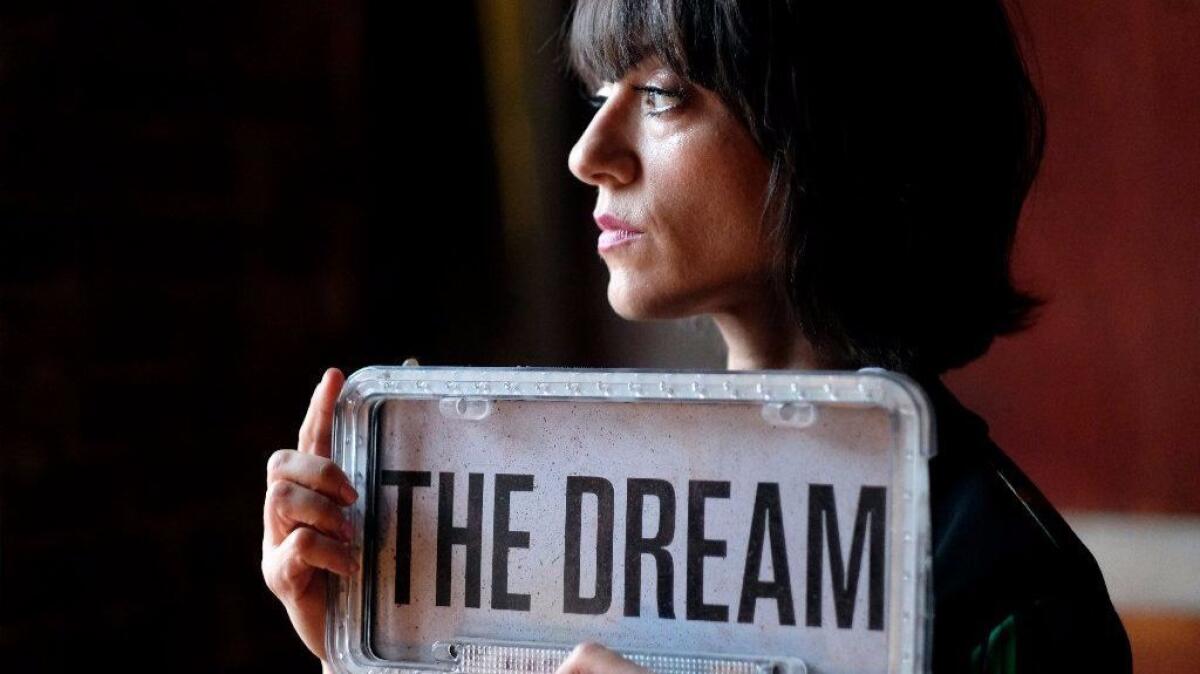Ana Lily Amirpour shoots from the gut with dystopian cannibal love story ‘The Bad Batch’

People have been asking Ana Lily Amirpour to explain herself a lot lately with the release of “The Bad Batch,” a psychedelic cannibal Western in which society’s undesirables are kicked out through a Texas border wall and left to wander the unforgiving wasteland. But answers don’t come easily with the gory quasi-love story that won Amirpour the special jury prize at the Venice Film Festival last year.
“It’s like having been deeply in love with somebody, and then two years later going to a wedding as their date and everybody in your families are confused by why you’re not together anymore,” the filmmaker explains with a wide grin, her eyes lighting up as she runs with the metaphor. “Because you do love them, and you did, madly and deeply.”
Sipping a cappuccino in her West Hollywood home, an airy converted duplex stylishly appointed with Banksy and Gregory Crewdson art books, a custom two-seater Atari cocktail console and an enviable collection of movies and pop culture ephemera, Amirpour has been mulling the strangeness of transporting herself back in time to the emotions that swirled as she made “The Bad Batch,” the striking follow-up to her 2014 Iranian vampire indie hit debut, “A Girl Walks Home Alone at Night.”
Characters maim, murder and munch on each other while pumping iron and blasting Ace of Base in Amirpour’s dystopian vision of America. They seek solace where they can find it, in makeshift families or under the rave-cult thrall of a sleazy Keanu Reeves. The film opens on Arlen, the sulking young heroine played by British actress Suki Waterhouse, who’s spit out by the system and quickly captured by cannibals, leading her to make irrevocable decisions as she thirsts for revenge against those who’ve wronged her.
I consider my feelings my job. I’m led into all these things I’m exploring by my feelings.
— Ana Lily Amirpour
The film, currently in limited release and also available on demand, pokes and prods its way through its sun-baked Jodorowskian hellscape, reluctant to offer easy moral justification for the bad things wrought by this batch of discarded souls. As an artist, Amirpour says, she is driven by feeling, even as inspiration comes from the harsh realities she sees in the world around her.
“I’m interested in the intersection of reality and fantasy,” says Amirpour, who found parallels to the isolated communities of “Bad Batch” outside her own door in Los Angeles. She started writing it while editing “A Girl Walks Home Alone at Night,” spending time with locals in downtown L.A.’s Skid Row and the off-the-grid community of Slab City in the Salton Sea.
Filming in 2015, she cast Bombay Beach-area locals to play residents of her desert oasis town, Comfort, alongside an unrecognizable Jim Carrey, who plays a vagrant samaritan living on the fringes of an already fringe sub-society.
“This notion of people that are getting systemically pushed into corners, it can be as literal or as metaphorical as someone needs it to be,” she says. “I’d go downtown and wander around 6th Street; it looks just like a refugee community.
“I get confused when people say [‘The Bad Batch’] is post-apocalyptic, because where are you looking? Where is your attention focused? I see homeless people. Every single person that lives on the street, I cannot not see them. But I feel that people habitually don’t see them.”
The film’s emotional imperative, on the other hand, sprang from Amirpour’s own life. “It was a broken heart,” she says, pausing. “A big broken heart. I felt like I would never feel that feeling again. If only a fortune teller could tell you, ‘No no, you’re totally going to be good in 2017’… imagine how different that would be! But I was feeling very alone, and very grim about it.”
An image of Arlen, discarded by society and mutilated by her peers, popped into her brain. “I thought of that girl in the desert, chopped up, bleeding, in pain, barely alive,” says Amirpour, “but she was going to live. And she was going to live. That was the beginning of the story.”

Born in the U.K., Amirpour moved to America with her Iranian parents, bounced around both coasts, and spent her formative years in Bakersfield, the arid oil capital of California. She was the only Iranian kid in her class in a town where “the polluted desert, the mall, country rednecks and Mexican gangs were my reality.”
Skate culture beckoned, and later gave her the idea of making “Girl,” a movie about a bloodsucking chador-clad heroine on a skateboard; so did the music of ’90s West Coast rappers like Ice Cube, and movies she’d watch with her father: “Bullitt,” “The French Connection,” “Dirty Harry,” “High Plains Drifter.”
“Girl,” her first film and a moody black-and-white, Persian-language genre piece, made a splash at Sundance and sold shortly thereafter, heralding Amirpour as a visionary feminist voice, a welcome new presence on the indie genre scene, and a rare female director of color in an industry dominated by older white men.
Her films, while aesthetically divergent, share the same pastiche-loving auteurist flair and center on isolated heroines straining to survive in the vicious worlds they’re born into. On her DVD shelf, copies of “Miami Blues” and “True Romance” are sandwiched between no fewer than seven — seven — Anna Nicole Smith documentaries in a stack of DVDs. “I am deeply obsessed with her,” Amirpour smiles.
I can’t speak for all filmmakers, but I’d guess that they all want for you to answer the questions.
— Ana Lily Amirpour
On the set of “The Bad Batch,” the energetic Amirpour “was an absolute predator for the cause, ready to go, always wearing some bonkers costume,” remembers Waterhouse. “She’s got those big giant chocolate eyes that just stare through you and look into your soul. She’s a breath of fresh air to be around.”
But Amirpour can be also be confounding to viewers seeking understanding of her work beyond what’s onscreen. Her films offer rich and loaded images, and sparse dialogue to explain them. As an artist, she’s more determined to ask questions than answer them.
“When you say something, it makes something more certain — and we strip away a lot of certainty by not speaking a lot [in the film],” Waterhouse said.
“[Arlen] is mad at the system in which these people live. She’s had her limbs taken away. She’s been dismembered by these people. With the truth of seeing things how they are, comes a lot of discomfort.”
An aversion to answers is partly how Amirpour found herself at the center of controversy over the intersection of race and violence at a Chicago Q&A during the “Bad Batch” press tour. When an audience member challenged her over the brutal violence that black characters in the film suffer, she answered: “Just because I give you something to look at, doesn’t mean I’m telling you what to see.” Criticism of the exchange spilled onto social media, sparking backlash so sharp it drove her off Twitter.
Addressing the “Bad Batch” controversy, Amirpour reiterates that the choices she made every step of the way were deliberate — and not meant to offend, but to spark deeper examination.
“I consider my feelings my job. I’m led into all these things I’m exploring by my feelings. I believe what I say, I believe in asking difficult questions through art and through these stories and through these characters,” she says.
“I’m an Iranian immigrant from another country. I’m brown! And I grew up and fought my way to my life, working really hard to do what I do and be where I am. I don’t have any concept of how it would be possible for someone to misunderstand me as an enemy of anybody.”
She says she is asking tough questions in “The Bad Batch,” even as she resists answering them herself. “Can one horrible action justify another? Can you break out of your system? Does everything we do originate out of our social conditioning?”
“Right now it’s one superhero movie after another [where] the fate of Earth all depends on one superhero, there are good guys and bad guys. That’s not what I see outside my door. I feel like we all need to take a look at how we treat each other,” says Amirpour.
She smiles. “Lionel Richie — do you know who he wrote that song ‘Hello’ about?” she asks. “Do you need to? It’s pure feeling… there’s something about that song that cuts my gut open.”
“I can’t speak for all filmmakers, but I’d guess that they all want for you to answer the questions.” Amirpour says she’s more interested in talking to people about what they respond to in her films, discovering what questions difficult scenes inspire in them, than explaining her own intentions.
And as a filmmaker courting controversy in the Internet age, she laughs, she’s a bit envious of pop idols like Lionel Richie and Michael Jackson, creators behind some of the most powerful music in history — whose songs, unlike certain challenging art films, get to speak for themselves. “Oh, those lucky musicians.”
More to Read
Only good movies
Get the Indie Focus newsletter, Mark Olsen's weekly guide to the world of cinema.
You may occasionally receive promotional content from the Los Angeles Times.











